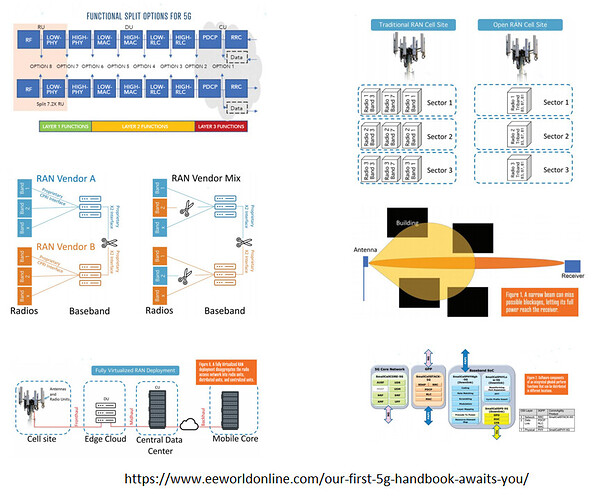5G is more than another wireless technology. It’s changed the radio, the access network, the spectrum, and the network core. It might even change our lives.
And theses guys from EE World created a great 5G Handbook.
See their introduction to the Handbook:
5G Technology World and EE World present our first 5G handbook, digital edition.
5G is undergoing rapid deployment. While consumers can get faster internet speeds, engineers know that 5G brings more than downloading movies. Indeed, the enhancements that 5G brings to wireless and wired networks will add Industrial specified in 3GPP Releases 16 and 17. Lower latency, more reliable connections, edge computing, and open radio access networks will provide businesses with new applications.
To help engineers understand the technology, we bring these 13 articles covering network timing, Open RAN, regulatory, compliance, over-the-air testing, spectrum sharing, power consumption, and mmWave radio. We look at the practical issues of radio and network design and test. In addition to the digital edition of the 5G Handbook, the articles also appear in HTML format. Indeed, we began posting them on Mondays in March 2021 and will continue through early June. We’ll update the article titles with links as they become available. All articles are available now in the digital handbook. Click on the cover image to read it online or download.
5G brings mmWave signals to the forefront of wireless engineering. “How to improve 5G coverage and capacity” looks at how engineers can overcome signal limitations imposed by mmWave signals with regards to user equipment.
Available bandwidth limits capacity. That’s where dynamic spectrum sharing helps, explained in “DSS lets 5G and LTE share spectrum.”
When it comes to base stations, “The challenges of building a 5G base station” covers the physical layer of 5G radios. That layer includes the radio’s DSP, often called the higher physical layer. Furthermore, base-station electronics use power, generate heat, and add weight to towers. “Size, weight, power, and heat affect 5G base station designs” takes you into the radio, stressing why these issues pose new design challenges with 5G.
Two articles in this handbook cover network timing, which gained importance in 5G. “Meet timing requirements in 5G networks” addresses RF timing, which must be stable enough to meet network time error requirements. “How timing sources synchronize open RAN networks” explains that because time-division duplex (TDD) depends on an understanding of timing, the network uses IEEE 1588 Precision Timing Protocol to synchronize transmitted and received signals. While time-based synchronization is becoming more common in the network, frequency-based synchronous Ethernet (SyncE) is also critical to system synchronization.
In Open RAN, some functions need not reside at the tower. They can reside elsewhere. That’s the functional-split concept. “Functional Splits, the foundation of an Open 5G RAN” explains the tradeoffs in locating functions in different locations. “Open RAN functional splits, explained.” An article not found in the handbook but available on 5G Technology World and EE World, continues the discussion. “Deploying and maintaining an Open RAN network” takes you through the components of Open RAN.
IoT devices are coming to 5G and they need antennas. ““5 tips for designing with embedded antennas” shows you how to connect and position antennas in your device. 5G’s wireless technology differs from that of 4G and “IoT: How 5G differs from LTE” explains those differences.
Remember that those who work at the upper protocol layers assume everything below works perfectly. To assure that, engineers need to test components, subsystems, systems, and networks. Devices that use mmWave signals require over-the-air testing, as “Why 5G needs over-the-air testing” explains. The 5G New Radio must comply with industry standards, covered in “5G radios increase emphasis on compliance testing.” Finally, “Simulate, test, and verify to solve 5G RF design Problems” brings the mmWave design cycle together.
We always welcome contributed technical articles.
Source (and Download):
